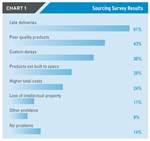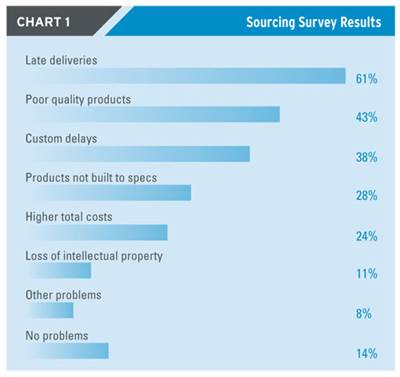Breaking Down the On-Shoring/Off-Shoring Debate
Dispelling five rumors.
Rumor 1: Rising tariffs are driving the resurgence in the on-shoring of mold building.
Fact: The truth is tariffs have been around and will continue to exist as long as people move finished goods from one country to another. The exact Import Duty paid will depend on the classification (Harmonized Code Number) used when making a Customs Declaration. There are also taxes in China that we need to be aware of – the dreaded VAT (Value Added Tax) of 17%. Remember, the supplier of an Exported Mold is able to claim back part or all of the VAT, as a buyer you should seek to recover that from the cost of the tooling.
Rumor 2: Freight charges are making it increasingly costly to do business in China.
Fact: Rising oil prices are impacting shipping charges. As a result, the cost of everything is going up. The best prices are available to the highest volume customers. Since molds rarely are shipped FCL (Full Container Loads), our products get the highest prices. We all pay for extra handling whenever we ship LCL (Less than Container Load). There are additional consolidation charges at the Port of Export and at the Port of Entry. It is important to know what the freight terms are for the shipment. From the supplier perspective, they will like to ship Ex – Works or some other similar terms. This means that you own the freight and all related transfer charges. Work with a reputable freight company, gain insight into INCO-TERMS and pick the one that is agreeable to both parties.
Rumor 3: Your intellectual property is at risk when dealing in China.
Fact: When dealing with a company 9,000 or 10,000 miles away we get a little edgy about this subject. The key is to know who you are dealing with. If you deal strictly with back room suppliers then you can expect your intellectual property to migrate out the door at the first available opportunity. But then again, the same could be said of our on-shore back room suppliers as well.
Rumor 4: Labor costs are skyrocketing in China.
Fact: In Guangzhou there have been staggering percentage point increases in the last two years. In 2010 we saw the base rate rise from ~900 RMB/Month to 1100 RMB/Month. Again in 2011 we saw the base rate rise from 1100 RMB/Month to 1300 RMB/Month. That is 20 percent Year over Year, and it is unthinkable in a Developed Economy. However, China is a “Developing Economy.” The middle class is all but non-existent in China, and the Government is trying to grow one up quickly. Let’s put the numbers in perspective. 900 RMB in 2009 was the equivalent of $132.00 for 160 hours monthly GROSS; 1100 RMB in 2010 was the equivalent of $162.00 for 160 hours monthly GROSS; and, 1300 RMB in 2011 is the equivalent of $202.00 for 160 hours monthly GROSS. So yes, there is hyper-inflation going on in China, but it is generally at the lowest wage earners level. Out of that money an employee must pay taxes, pay for housing, food, medical (if he/she is not a locally registered resident) and savings (the factory may have dormitories, but they are not free).
Rumor 5: Real estate prices are on a huge bubble in South China.
Fact: The residential market is seeing significant growth all over Guangdong Province, especially in Guangzhou and Shenzhen, which is having a carryover effect in the commercial markets. With rising costs for rent or purchase for expansion, moldmakers are moving further inland. As a result of the moves, they are seeing some employees stay behind and change companies. In the Xintang area, mid-way between Guangzhou and Dongguan there is a residential community that is building 26 peeks or 26 high-rise—maximum density housing projects. Cranes are visible on every horizon and the topography of the region is changing daily. This is part of the housing bubble that the central government is trying to contain. It is also important to remember, in China you own the building, but the People of China own the land. You can secure a 99-year lease on what you perceive as your piece of the rock, but it will eventually revert to the People of China.
Contributor:
Scott L. Peters is Operations Manager for a multi-national manufacturer in Guangzhou China. He serves the Mold Making and Mold Design Division of the Society of Plastics Engineers as Division Chair Elect. Scott is the owner and founder of Molded Marketing LLC. He makes his U.S. home in Owensboro, KY.
Related Content
MMT Chats: Solving Schedule and Capacity Challenges With ERP
For this MMT Chat, my guests hail from Omega Tool of Menomonee Falls, Wisconsin, who share their journey with using enterprise resource planning (ERP)—and their people—to solve their schedule and capacity load monitoring challenges.
Read MoreMaking Quick and Easy Kaizen Work for Your Shop
Within each person is unlimited creative potential to improve shop operations.
Read MoreTackling a Mold Designer Shortage
Survey findings reveal a shortage of skilled mold designers and engineers in the moldmaking community, calling for intervention through educational programs and exploration of training alternatives while seeking input from those who have addressed the issue successfully.
Read MoreOEE Monitoring System Addresses Root Cause of Machine Downtime
Unique sensor and patent-pending algorithm of the Amper machine analytics system measures current draw to quickly and inexpensively inform manufacturers which machines are down and why.
Read MoreRead Next
Creating a Competitive Cost Model in the U.S.
Recent China trends present opportunities for U.S. manufacturers and supply chains.
Read MoreHow to Use Continuing Education to Remain Competitive in Moldmaking
Continued training helps moldmakers make tooling decisions and properly use the latest cutting tool to efficiently machine high-quality molds.
Read MoreReasons to Use Fiber Lasers for Mold Cleaning
Fiber lasers offer a simplicity, speed, control and portability, minimizing mold cleaning risks.
Read More
















